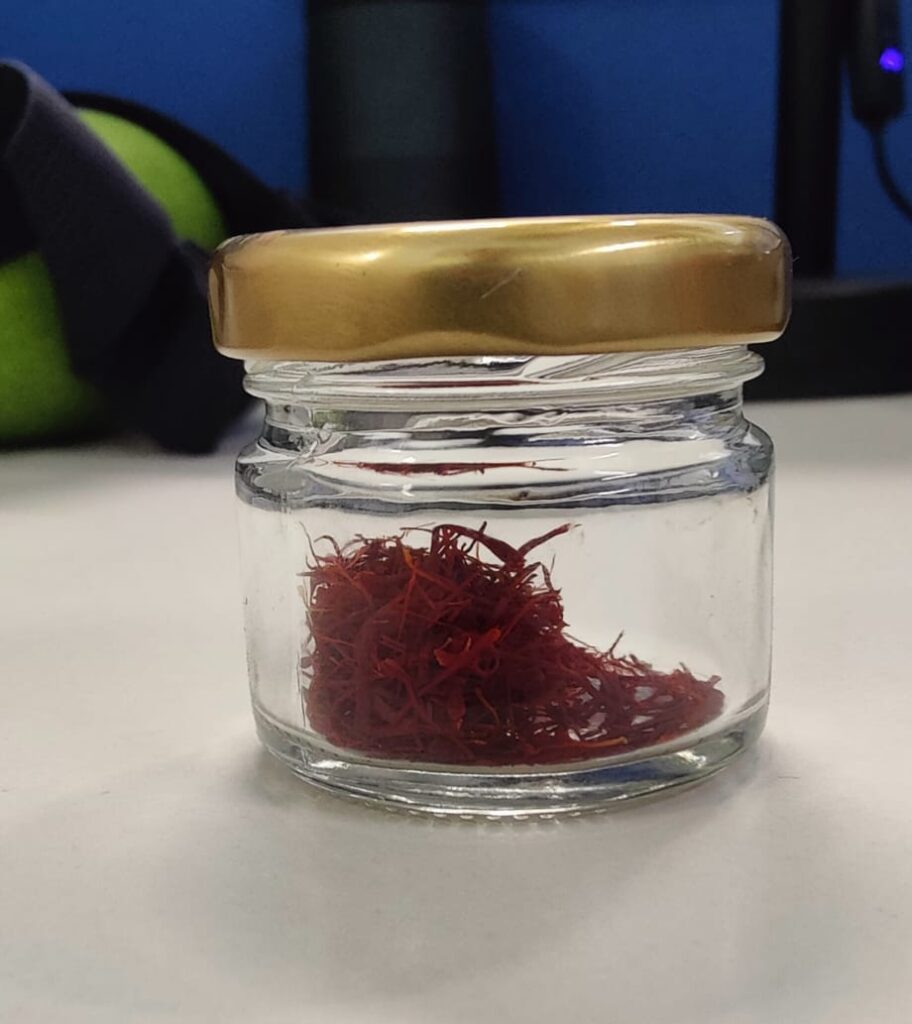From Kashmir to Your Kitchen: Unlocking the Rich Flavor of Saffron
1. Introduction- Brief history of saffron cultivation in Kashmir
Kashmir, the picturesque valley in the northern region of India, is known for many things – its stunning landscapes, rich culture, and delicious cuisine. But one of the most prized treasures of Kashmir is its saffron, often referred to as the “golden spice.” In this article, we will explore why Kashmir’s saffron is considered the best in the world.
2. Climate and Soil Conditions for cultivating Saffron
The unique climate of the Kashmir Valley, with cold winters and moderate summers, provides the perfect conditions for saffron cultivation. The soil in this region is also ideal for growing saffron, with its rich nutrients and good drainage.
3. Cultivation Process of Saffron
Saffron is the stigma of flowers. There are about three or four stigmas in each flower. Its cultivation is completely done manually by the Kashmiri people. They pluck these stigmas with their hands and then dry them separately. Saffron has been used for many centuries. It is being used by the pharma company, therapy, dye industry etc.
4. Unique Features of Kashmiri Saffron:
What sets Kashmir’s saffron apart is its distinct aroma, intense flavor, and deep, rich color. These unique features make it the go-to spice for adding a touch of luxury and sophistication to any dish.
4. Quality and Purity of Kashmiri Saffron
Kashmiri Saffron is of the highest quality because of the high amount of crocin in it. Crocin gives colour and medicinal properties to saffron. The amount of crocin in Kashmir’s saffron is 8.72 per cent, while the same amount in Iran’s saffron is 6.82 per cent. It is cultivated at an altitude of 1600 meters above sea level.
Determining the “best” saffron in the world can be subjective, as preferences may vary based on personal taste and culinary requirements. However, there are a few regions that are renowned for producing high-quality saffron. These regions include:
No. 1: Kashmir, India
On top of our list is Kashmir Saffron. Known for its saffron, this region produces saffron with a deep red colour, strong aroma, and robust flavour. Kashmiri saffron is highly regarded for its quality and is often considered among the finest in the world.
Kashmiri saffron, also known as Kashmiri Kesar or Kashmir Saffron, is highly regarded for its exceptional quality and is considered among the finest saffron varieties in the world. It is cultivated in the Kashmir region of India, where the climate and soil conditions create an ideal environment for saffron production.
Here are some key characteristics of Kashmiri saffron:
- Deep red colour: Kashmiri saffron threads have a rich and vibrant deep red colour, which is indicative of its high-quality and potency.
- Strong aroma: The aroma of Kashmiri saffron is intense and distinct, often described as floral, earthy, and slightly sweet. The fragrance adds depth and complexity to dishes.
- Robust flavour: Kashmiri saffron has a robust and distinct flavour that is often described as floral, honey-like, and slightly bitter. It lends a unique taste to a variety of culinary creations.
- High crocin content: Crocin is the compound responsible for the vibrant red colour of saffron. Kashmiri saffron is known for its high crocin content, which contributes to its intense colour and potency.
- Labour-intensive cultivation: The cultivation of Kashmiri saffron involves meticulous handpicking of the delicate saffron threads from the Crocus sativus flowers. This labor-intensive process ensures the preservation of saffron’s quality and integrity.
No. 2: Iran
Iran is the largest producer of saffron globally, and its saffron is highly esteemed for its intense colour, distinct flavour, and potent aroma. Iranian saffron, often referred to as Persian saffron, is sought after for its superior quality.
When comparing Iranian saffron and Kashmiri saffron, both varieties have their own distinct characteristics and qualities.
Here’s a comparison between Kashmir and Iranian Saffron:
- Colour: Both Iranian saffron and Kashmiri saffron exhibit a vibrant red colour. However, Kashmiri saffron is known for its slightly deeper red hue, while Iranian saffron tends to have a slightly brighter red colour.
- Aroma: Iranian saffron is renowned for its strong and distinct aroma, which is often described as floral, honey-like, and earthy. Kashmiri saffron also possesses a strong aroma but is often noted for its sweet and delicate fragrance.
- Flavour: Iranian saffron is characterised by a robust and slightly bitter flavour profile, with hints of floral and honey notes. Kashmiri saffron, on the other hand, is known for its subtle and slightly sweeter flavour.
- Crocin content: Both Iranian saffron and Kashmiri saffron have high crocin content, which contributes to their vibrant red colour. However, the exact crocin levels may vary depending on factors such as cultivation practices and growing conditions.
- Cultivation and origin: Iranian saffron is primarily cultivated in Iran, particularly in regions such as Khorasan. On the other hand, Kashmiri saffron is cultivated in the Kashmir region of India, which is known for its unique climate and soil conditions favourable for saffron production.
Ultimately, the choice between Iranian saffron and Kashmiri saffron depends on personal preference and the specific culinary application. Both varieties are highly esteemed and valued for their quality, and both have a long history of traditional use in various cuisines. However, based on above facts, Kashmiri Saffron is ranked as no.1 in our opinion and definitely has more of a superior premium look, taste and flavour.
No. 3: Spain
Spain is another prominent producer of saffron, particularly in the region of La Mancha. Spanish saffron is known for its sweet aroma, and delicate flavour. It is widely used in Spanish cuisine and is regarded globally.
While Spanish saffron is generally regarded as high-quality and sought after, there have been some concerns and issues associated with it.
Here are a few common issues that can arise with Spanish saffron:
- Counterfeit or adulterated saffron: Due to its popularity and high market value, there have been instances of counterfeit saffron being sold as Spanish saffron. Adulteration may involve mixing genuine saffron with lower-grade saffron or even substituting it with other spices or saffron substitutes. It is important to purchase Spanish saffron from reputable suppliers who can provide proof of authenticity.
- Variability in quality: While Spain is known for producing high-quality saffron, there can be variations in quality within different batches or grades of Spanish saffron. Some lower-grade Spanish saffron may have lower levels of the desired compounds such as crocin, which can affect its colour and flavour profile.
- Pricing: Spanish saffron can sometimes be more expensive compared to saffron from other regions. This is partly due to the cost associated with its cultivation and the meticulous hand-harvesting process. However, it is essential to be cautious of overly inflated prices that may not be justified by the saffron’s quality.
Packaging and storage: Improper packaging or storage of Spanish saffron can lead to a loss of aroma, flavour, and colour over time. It is recommended to store saffron in airtight containers, away from light and moisture, to preserve its quality.
5. Health Benefits of Saffron
Apart from its culinary uses, Kashmiri saffron is also valued for its numerous health benefits. It is rich in antioxidants and has anti-inflammatory properties, making it a popular ingredient in traditional medicine practices.
6. Culinary Uses of Saffron
Kashmiri cuisine, saffron is an essential ingredient that adds a flavor and color to dishes like pulao, kebabs, and desserts. The aroma of Kashmiri saffron is unmatched, making it a favorite chefs and home cooks. Influence of saffron on Kashmiri cuisine.
Click here to know about the recipes using Saffron
7. Global Demand of Kashmiri Saffron
The demand for Kashmiri saffron continues to grow worldwide, with its reputation for quality and purity attracting discerning customers. Despite its premium price, Kashmiri saffron remains in high demand in the global market.
8. Conclusion:
In conclusion, Kashmir’s saffron truly deserves its title as the best in the world. Its superior quality, rich history, and cultural significance make it a treasure worth savoring. Whether in the kitchen or on the dining table, Kashmiri saffron adds a touch of magic that elevates every culinary experience.

